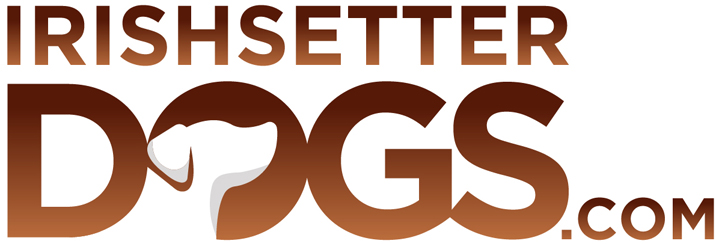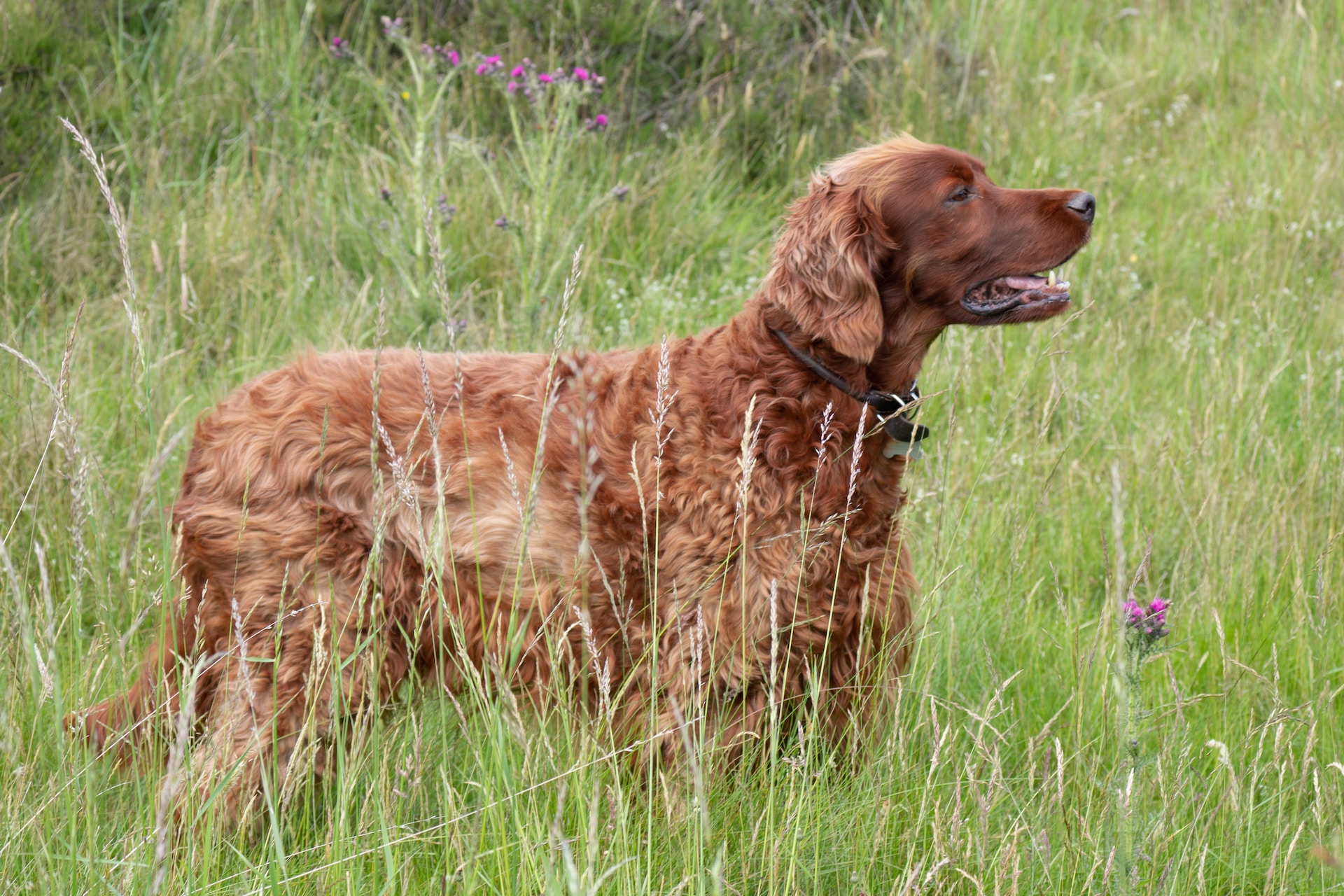Do you want to discover the causes and treatments for hair loss in Irish Setter? Your Irish Setter needs more hair, as you have already seen. Similar to how you worry about your Irish Setter, you continually pick up Irish Setter hairs, brush your clothing, and shake your carpets. This breed of dog does have a double coat that has to be shed twice a year. The winter coat is taken off in the spring, and the summer coat is taken off in the fall.
Numerous factors, like seasonal shedding, allergies, or serious illnesses like alopecia, might cause your Irish Setter to lose hair in patches. Due to their lengthy fur becoming tangled in various objects or falling out when playing, they could also lose some hair throughout the year. Some dogs of this breed may have a little odor when they lose their fur and hair.
They shouldn’t have such a foul odor if you frequently groom them. If you do not regularly groom them, they will smell even worse. In this article, I have listed all the possible causes and treatments for hair loss in Irish settlers. So let’s continue!
Irish Setters Require Regular Grooming
You must regularly groom them if you want to stop their hair loss. However, you may wind up brushing your Irish Setter two to three times each week since dirt, mattes, and knots may quickly get into their fur. You don’t need to wash them as often, however. This dog breed must only be cleaned four or five times a year except when they roll around in the mud, dirt, or other nasty stuff.
It would be best if you were on the lookout for ear infections. The airflow required to keep these dogs’ long ears clean and clear of germs is not provided. While you may be concerned about keeping the dog hair from coming out, remember to check their ears often.
When you need to manage the dropping hair on your Irish Setter, there are tried-and-true techniques you may apply. Since they have a double coat, you should use a shredding tool to collect the undercoat hairs before falling to the ground.
Be on the lookout for allergies or illnesses as well. These are the causes of canine hair loss. The appropriate prescription ought to make things better. Remember to give your dog a satisfying, healthy supper daily. Always remember about supplements if such measures need to be improved to regulate hair loss. But with your veterinarian first before giving them to your dog. In this manner, your dog won’t get pointless vitamins that are useless to them.
Hair Loss in Irish Setters Causes
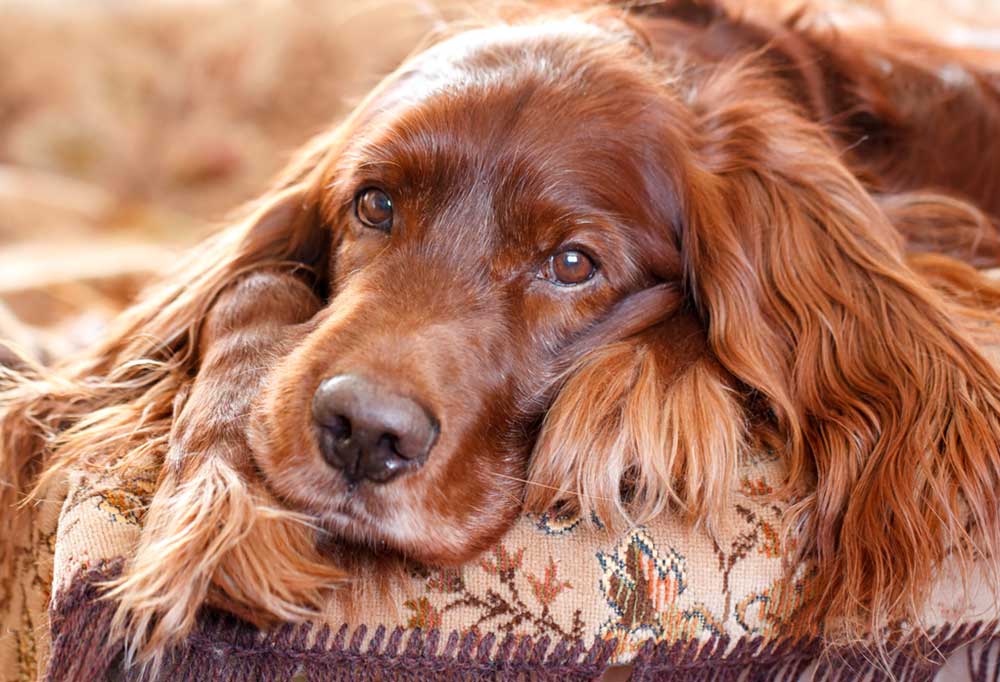
Numerous reasons, like shedding, or more serious illnesses like alopecia, might cause your Irish Setter to lose hair in patches. Irish Setter’s hair loss reasons are discussed below, along with treatments. There are several causes behind your Irish Setter’s hair loss patches. Some are regular, seasonal loss, fleas mange, other mites, and even hormonal fluctuations. Naturally, there is also baldness to watch out for.
🐶Seasonal Shedding
Unwanted hair on your Irish Setter may be removed and reduced by brushing him twice a week. Irish Setters lose their fur as the weather becomes warmer, and their hair becomes brittle or damaged, or both. For instance, Labradors and Irish Setters have thick cold undercoats that they slough off in the spring. Seasonal shedding typically decreases if you live in a moderate climate.
🐶Manage
Mites bring on a painful and itchy skin disease called mange. Mites are tiny creatures that live on the skin’s surface or in hair follicles. Some mites, like the scabies mite, spread quickly between people and dogs. Your veterinarian might prescribe an antiparasitic medication if you find mites or fleas on your Irish Setter.
🐶Alopecia
Alopecia is a condition that affects a lot of people. Either thinning hair or bald spots (patches of hair loss) are mentioned. Seasonal flank alopecia and shedding are not the same thing. Although seasonal shedding in Irish Setters may vary considerably from breed to breed and even within a single dog, it is a typical component of their natural hair growth cycle.
🐶Allergies
The most typical signs of allergies in dogs, as in people, are itchy skin & hair loss. The most prevalent allergies in Irish Setters are those to environmental irritants such as pollen, dust mites, mold, fleas, and food. However, you should be aware that food allergies are only identifiable after at least eight weeks of meal trials.
🐶Parasites
Irish Setters may lose hair due to a flea or skin mite infection. When fleas bite, their saliva triggers the body’s immune system. Puppies with flea saliva allergies have severe itching and skin inflammation across their whole bodies. They often lick, scratch, and gnaw at their skin, which causes hair loss, wounds, and infections. Irish Setters’ hair follicles are home to Demodex mites. Demodectic mange, a disorder that causes sores, thickening of the skin, & hair loss, may sometimes be brought on by an excess of mites in young pups and immune-compromised adults.
🐶Bacterial Infection
Like people, Irish Setters may have bacterial or fungal skin disorders. A bacterial skin infection is called pyoderma, particularly when the skin is red & pus-filled. The yeast on an Irish Setter’s skin may overgrow, leading to candid infections, sometimes known as yeast infections. Tinea, also named for ringworm, is a fungus that results in dry skin and brittle hair in rounded areas.
🐶Poor Nutrition
Irish Setters in caring households only experience malnutrition if there’s competition from other pets. But some puppies have more specific nutritional requirements than others. Growing puppies need more calories, protein, and fat to support their development, and dogs with certain medical issues may also need dietary changes to maintain good skin and hair. Finding the ideal diet for your dog’s requirements might be challenging. Ask your veterinarian for advice on preventing hair loss in Irish Setters.
🐶Stress-Related Hair Loss
If your Irish Setter has been a comprehensive examination by a veterinarian and the reason for his significant hair loss is still unknown, stress may be the culprit. Vomiting, diarrhea, and excessive clawing or licking are a few physical signs of severe anxiety brought on by separation and changes in the household. Irish Setters that repeatedly lick one area of their bodies may develop sores or skin illnesses known as acral lick dermatitis. This habit will result in more than bald patches.
Some dogs struggle with anxiety their whole lives; for others, it is brought on by a particular event. Examine your schedule to see if it has recently changed, and consider if there may be a stressor at home, such as a building project, a new baby, or the death of another pet. In addition to treating the medical symptoms, your veterinarian may suggest drugs, herbal supplements, or a meeting with a qualified behaviorist.
🐶Illnesses
Even though we detest the idea of our puppies having a terrible illness, Irish Setters might have abnormal hair loss due to a few disorders. Hypothyroidism, which is extremely prevalent in dogs, develops when the thyroid gland cannot generate enough hormones. The adrenal glands of Irish Setters that have Cushing’s disease produce too many corticosteroids. Cushing’s disease risk is enhanced in animals receiving long-term steroid treatment as advised for other medical issues.
Irish Setter Alopecia: Signs & Causes
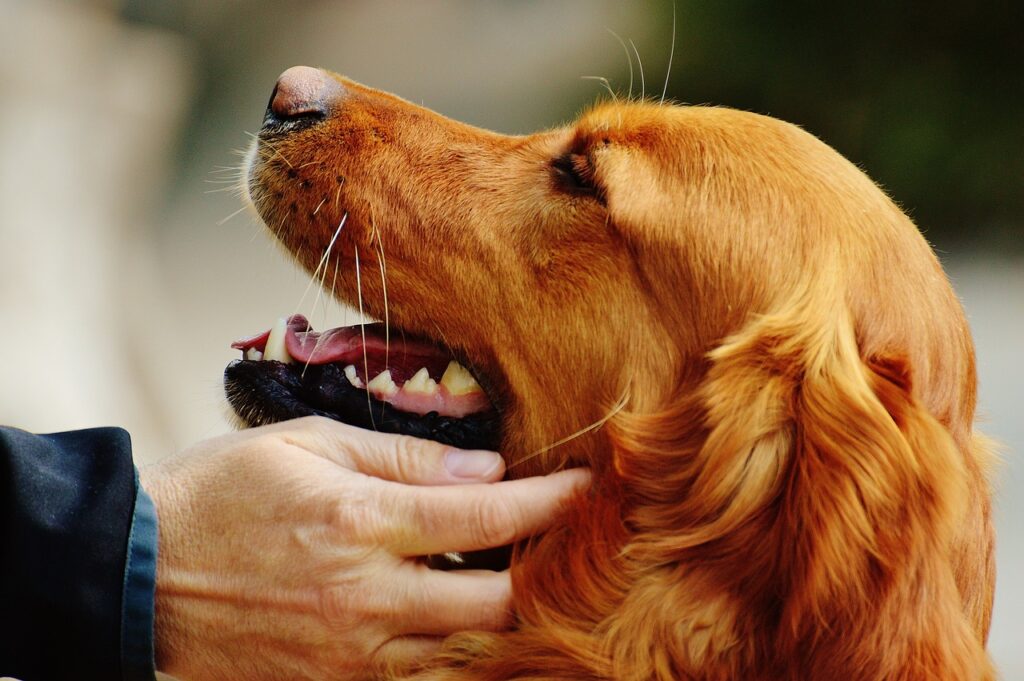
The following signs of alopecia may be present:
◽️Varying degrees of scratching
◽️Red, inflamed, swollen, oozing, bleeding, foul-smelling, or pigmented skin
◽️Papule-covered skin
Alopecia also has a wide range of reasons, some of which are as follows:
◽️Bug bites and ectoparasites
◽️Infections and allergies to the skin
◽️Biological propensities
◽️Immune system diseases, hormonal disorders
◽️Cause of the environment
◽️Dietary causes
Breeds Predisposed to Alopecia
Although any dog could develop alopecia, certain breeds, such as Mexican Hairless, Irish Setters, Bulldogs, Dobermans, Yorkshire Terriers, Chinese Crested, Greyhounds, Dachshunds, Pomeranians, Siberian Huskies, Golden & Labrador Retrievers, & West Highland White Terriers, appear to be predisposed to the condition.
It’s crucial to remember that every dog exposed to subpar husbandry procedures (breeding and care), particularly pups, runs the danger of developing mange.
Shedding Irish Setter
Irish Setters lose on average, but like other dogs with a double coat, they blow coats in the spring and autumn, which causes them to shed more. The hair will be more prominent than in other breeds, with finer, shorter, lighter hair because of the color (most often red) and length (medium to long) of the hair.
Additionally, they shed more hair overall since they are a bigger breed with greater surface area than a smaller breed. There is more hair to go around, which is not to argue that bigger dogs shed more than smaller dogs.
So if you’re searching for a breed that sheds little, there is a better breed for you. Even though they are quite controllable, they need some grooming, particularly if you want to lessen the quantity of hair left in your house.
Preventing Hair Loss in Irish Setters
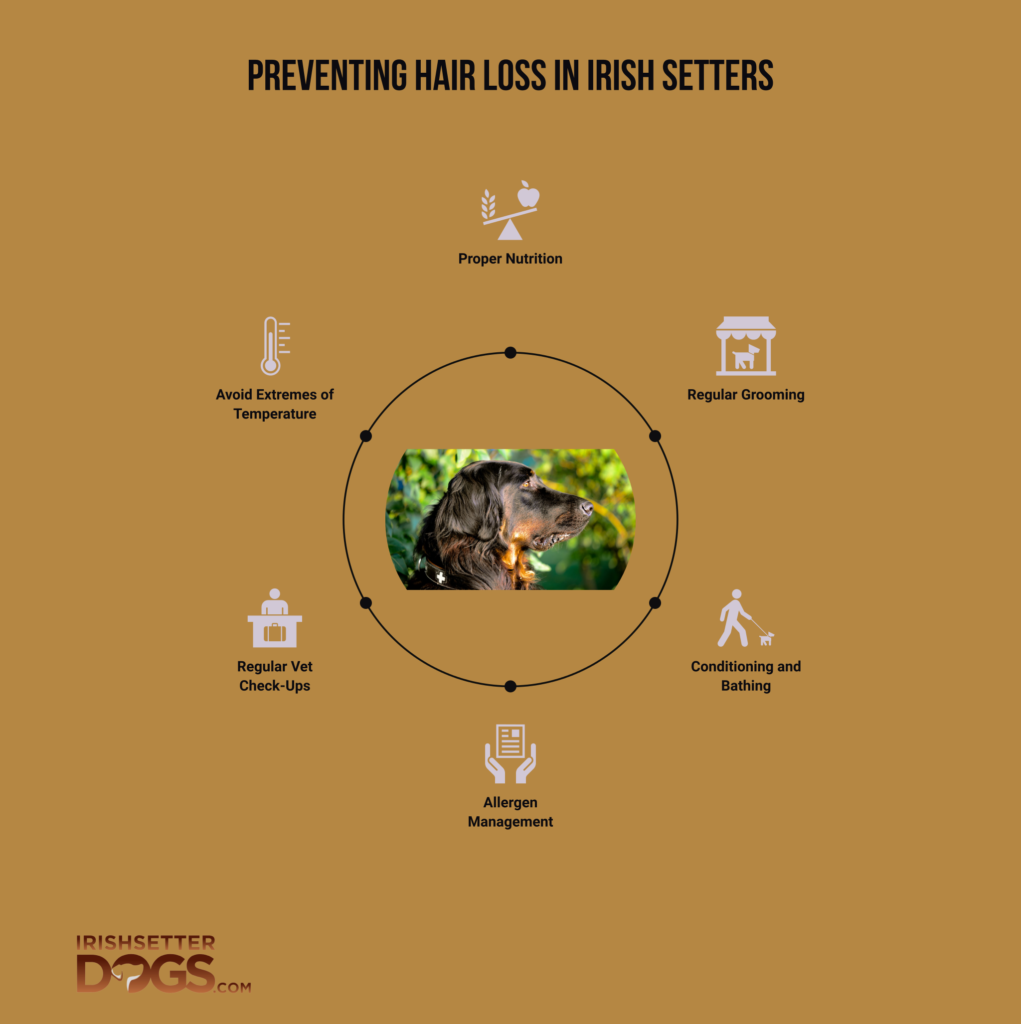
Irish Setters may have hair loss for various reasons, including heredity, dietary inadequacies, allergies, hormone imbalances, or underlying medical conditions. You must speak with a veterinarian to identify the precise reason for your Irish Setter’s hair loss and create an effective treatment plan. However, the following general advice might lessen hair loss in Irish Setters:
☑️Proper Nutrition
Make sure your Irish Setter eats balanced food that satisfies their dietary requirements. To maintain a healthy coat, high-quality dog food with sufficient protein, fatty acids (such as omega-3 and omega-6), vitamins, & minerals is essential. Ask your veterinarian for the ideal food for your dog’s unique requirements.
☑️Regular Grooming
Regular brushing helps eliminate loose hair, stimulates the epidermis, and distributes natural oils over the coat of your Irish Setter. Use a brush or comb that is appropriate for the sort of coat that they have. Grooming allows you to see any anomalies or skin problems early on.
☑️Conditioning and Bathing
Wash your Irish Setter using a mild, canine-specific shampoo and conditioner. Avoid washing them often since this might deplete their coat of natural oils. Properly rinse the coat to avoid any residue accumulation, which might irritate the skin.
☑️Allergen Management
If your Irish Setter is prone to allergies, you should locate and eliminate the triggers. Certain foods, environmental elements (pollen, dust mites), or contact allergies (such as certain textiles or cleaning supplies) are examples of common allergens. Your veterinarian may assist you in identifying the exact allergies and suggest the best course of action, such as dietary adjustments or using hypoallergenic goods.
☑️Regular Vet Check-Ups
To protect the general health of your Irish Setter, schedule routine veterinary checkups. The veterinarian can determine if any underlying health conditions are causing hair loss and provide suitable treatments.
☑️Avoid Extremes of Temperature
Temperature extremes may be harmful to the health of your dog’s coat. By giving your Irish Setter the right shelter, reducing their exposure to inclement weather, and steering clear of extended sun exposure, you may shield them from extreme heat or cold.
Remember that engaging with a vet is essential to identify the precise reason behind your Irish Setter’s hair loss. They may provide specific guidance and suggest therapies tailored to your dog’s needs.
Irish Setter Hair Loss Diagnosis
A veterinarian should inspect your Irish Setter if they’re losing their hair to identify the underlying problem and provide any necessary treatments. Based on the beginning of symptoms, hair loss pattern, skin condition surrounding the hair loss, and if the Irish Setter is itchy or uncomfortable, a diagnosis is made.
🔍Hair Loss Pattern
A bacterial infection or mange might be the cause of generalized hair loss. Patches of hair loss may be a sign of mange, ringworm, bacterial infection, or mites. A flea allergy is often blamed for hair loss in the rump & tail base region. Atopy, or environmental allergies, may occasionally cause hair loss on the face and paws. Symmetrical hair loss may indicate an endocrine disease such as a thyroid illness, adrenal gland disorder, or abnormal sex hormone levels.
🔍Blood Profile
Blood tests may be used to identify Cushing’s disease, diabetes mellitus, thyroid diseases, immune system disorders, and hormone imbalances.
🔍Biopsy
The veterinarian may wish to send a sample of the afflicted region to the lab for diagnosis and treatment if skin cancer, a tumor, or chronic, non-healing skin lesions are detected.
🔍Smears of Skin Impressions
Examining the afflicted region using a microscope slide might reveal the existence of yeast, bacteria, and inflammatory cells.
🔍Skin Scraping
Mange mites may be found by gently scraping the skin with a blade to collect hair follicles onto a slide.
🔍Luminescence
Under UV light, some ringworm species emit a brilliant green-yellow glow.
🔍Trials to Eliminate Allergens
A food allergy may be discovered by feeding a hypoallergenic diet, treating fleas, or quitting using certain shampoos or medications.
🔍Allergy Test
Blood and skin testing may reduce the list of probable environmental allergens.
Recovery of Hair Loss in Irish Setters

Depending on how prone your Irish Setter is to skin infections, hair loss may need many treatments. Always follow the veterinarian’s recommendations when administering medication. It may be important to schedule follow-up sessions to ensure the issue is solved and any infection is healing. Keep an eye on the skin and hair growing back on your Irish Setter, and let the vet know if there are any changes or issues so they can alter the course of therapy.
Maintaining a peaceful environment for your Irish Setter, looking for fleas in the home, and ruling out mange might all help avoid hair loss. If the symptoms are mild, consider feeding your dog a hypoallergenic dog food. You should also consider the sort of dog food they are consuming.
Getting your puppy inspected by a veterinary specialist if you are still waiting to see progress after implementing the ideas mentioned earlier is crucial.
Frequently Asked Questions
Are Irish Setters Hair or Fur?
Irish Setters have a top coat that resembles hair but is real fur because, unlike human hair, it stops growing & sheds when it does. Thick, silky hair makes up their undercoat.
What can I do to cure my dog’s hair loss?
Melatonin is a common therapeutic option if you want to address this problem only for aesthetic reasons. After ruling out any more potential reasons for your dog’s hair loss, your veterinarian can assist you in determining the proper dosage. Hair usually grows back after taking melatonin for 2-3 months.
Why is my dog losing hair now?
Stress, poor diet, pregnancy, nursing, or any underlying medical condition may all contribute to excessive shedding. Make an appointment with your veterinarian if you believe your dog is shedding more than usual or if you see any bald spots on him.
What lack in dogs results in hair loss?
Zinc deficiency results in hair loss, skin ulcers, and thickening and cracking of some skin regions, especially around joints and foot pads. With enough levels in the diet, mineral deficiency-related skin symptoms immediately disappear.
Should I be worried that my dog is losing hair?
Dog hair loss should not be taken lightly since it may indicate a severe medical disease that has to be treated. Therefore, you should call your veterinarian immediately if you see bald areas on your dog or if they appear to be shedding more than usual.
Final Thoughts
After all the studies, it is obvious that hair loss in Irish setters is a significant problem that requires attention. Irish Setters’ hair loss is a serious issue that impacts their health and appearance. Irish Setters may be kept happy, healthy, and able to preserve their distinctively lovely coats by taking a proactive approach to their general health, which includes routine grooming, precautions against parasites, and treating any underlying issues. I hope this article helps you a lot.
